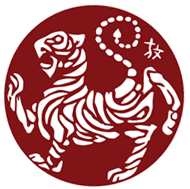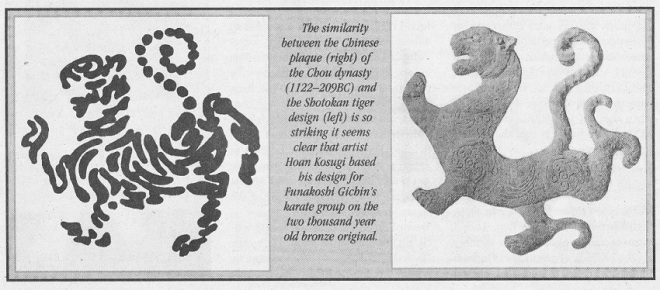
NOTE: The following is part of an article adapted from 24FightingChickens – Shotokan Karate: http://www.24fightingchickens.com/2005/10/07/shotokan-tiger/ but also from other sources.
When a student of karate hears the term “Shotokan Tiger,” one image comes to mind: the traditional symbol of the tiger inside the circle which has become representative of Shotokan Karate.
The drawing was originally created by a Japanese man named Hoan Kusugi who was a friend and student of Funakoshi. Hoan Kosugi, a famous artist and president of the Tabata Poplar Club, an artist’ guild, was a little known but very important figure in the development of Shotokan Karate-do in Japan.
To entice Funakoshi, to write a book about Karate, Hoan Kosugi told Funakoshi that if he would write the book, Kosugi would design it and provide a painting for the cover. When Gichin Funakoshi produced the book, Hoan Kosugi produced the now famous Shotokan tiger
“Ryukyu Kempo: Tode”, Funakoshi’s first book about karate, was written in 1922, but the plates for that original book were destroyed in the fire of the Great Kanto Earthquake in September of 1923. Later that year, Funkoshi released the book again, this time under the name of “Rentan Goshin Jutsu” .
His idea for the tiger came from the expression “Tora no maki.” Tora no maki, in Japanese tradition, is usually translated as “master scroll” or “master text.” It is the official written document on long scrolls of an art or system, which is used as the definitive reference source for that particular art. The picture of the tiger in the circle is a pun on the words “Tora no Maki”. Since “tora” also means “tiger”, … “Scroll of the Tiger”. Already by Funokoshi’s time, this practice had been long abandoned, but the name stuck.
Since no books had ever been written about Karate, Hoan Kosugi told Funakoshi that his book was the Tora no maki, of Karate. He designed the tiger as a representation of Funakoshi’s art.
The tiger in the traditional circular image is a traditional Chinese design that implies “the tiger never sleeps.” It symbolizes, therefore, the keen alertness of the wakeful tiger and serenity of the peaceful mind. Also the tiger drawn within a circle could be meant to show that the power of the tiger, like the power of Shotokan, is contained. It indicates that this power should never be used on a whim. The power is only unleashed, or broken from the circle, in order to defend ourselves or others who can’t defend themselves from a violent attack. The kanji character up in the upper right corner of the circle is part of the artist’s name, Hoan Kusugi,
Presently, the Shotokan Karate is is synonymous with the tiger symbol and many Shotokan Karate clubs use as a symbol or logo for their dojo or association. However, the Japan Karate Association still chooses to use the “inyo”as their primary symbol. Few people understand the relationship of shoto, to what is commonly called the “shotokan tiger.”
When Gichin Funakoshi was a young man, he enjoyed walking in solitude among the pine trees which surrounded his home town of Shuri. He would often walk up Mt. Torao and meditate among the pine trees under the stars and bright moon. Mt. Torao is a very narrow, heavily wooded mountain which, when viewed from a distance, resembles a tigers tail. The name “Torao” literally means “tigers tail”, and it is because of this that people think Funakoshi chose the tiger symbol. There is some skepticism behind this.
Later in life, Funakoshi explained that the cool breezes which blew among the pines on Mt. Torao, Tiger’s Tail Mountain, made the trees whisper like waves breaking on the shore, thus, since he gained his greatest poetic inspirations while walking among the gently blowing pine trees, when he signed his poems he used the pen name, “shoto”, which literally means “pine waves or waving pines”.
The name SHOTOKAN was made up using Shoto, and the word Kan meaning house or school. Thus Shotokan means the house or school of the waving pines, but today is interpreted as the Karate school or Karate method of Funakoshi.


This article is one of the best article I have read on this topic. Your article is very informative and I must appreciate your writing skills. Thank you for writing such an amazing article. I am definitely gonna share it with my friends. Keep writing such fresh and new content.
LikeLike
One of the best articles I’ve read on this topic. I love it! Thank you so much for all the valuable information!!
LikeLike
Thank you for your kind words. It is sad that 24fighting chickens who did so much research on Shotokan Karate is not on the web anymore. His articles made me want to research more information about symbols used in karate and how we practice interpret karate. “The Karate Nerd” is an interesting modem source on the internet as well !
LikeLike
Yes I believe the Shotokan Tiger is inspired by a Chou Dynasty (1122-209 BC) plaque. See the picture in my blog and decide for yourself.
LikeLike